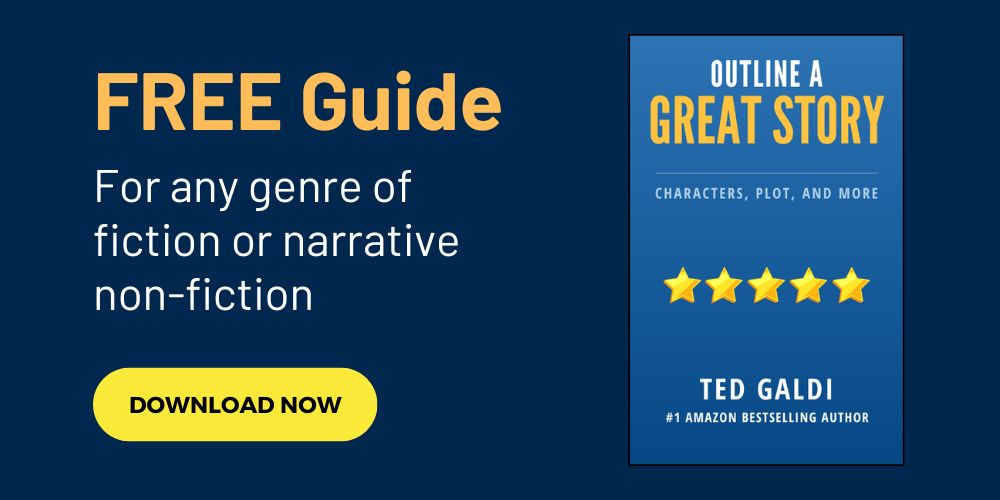Character Development: 5 Tips for a Great AntagonistCheck out these 5 character development tips for an unforgettable antagonist. Want even more advice? Download my FREE story-outlining guide What's an antagonist?Any character who tries to prevent your protagonist - ie, the hero - from achieving their goal in the story. For instance, in the film Rocky, hero Rocky has a goal to win a championship boxing match. The opposing fighter, Apollo, is an antagonist since he's trying to win the match instead of Rocky. Stories can have more than one villain, however, I'd recommend choosing a single main antagonist who'll be responsible for most of the obstacles preventing your hero from achieving their goal. How do you write a great antagonist?No one way exists for creating a great villain in storytelling. However, certain antagonists have had more resonance with audiences than others over the thousands of years people have been telling stories, and commonalities have been found among them. Here are five useful character development tips for your main antagonist... Character Development Tip #1: Give your villain an understandable reason for bad actionsEmpathy is critical in character development. Your audience should understand the decisions your characters make, even if it doesn't agree with those decisions. A villain who does horrible things for no apparent reason could be an intimidating obstacle in your story, however, the character would lack humanity. Real people tend to do things - both good and bad - for a reason. For your characters to feel authentic, they should behave like real people (even if they happen to be supernatural). Here are a pair of recommended techniques for making your antagonist's dark decisions understandable:
Character Development Tip #2: Make your antagonist more imposing than your protagonistAt the start of your story, the odds of winning should be stacked against your hero. Your main antagonist should seem to have the advantage in traits that tend to determine the winner of the climactic confrontation your story is building toward. For example, if you're telling a crime story, your protagonist detective may be the sharpest cop in their town, however, the thief they're going up against is considered the best in the country, a clear favorite in a battle of intelligence. If you're telling a science-fiction story, your main character may be a great soldier, but only human, while the central antagonist is a robot five times stronger and faster than any person. This imbalance of power makes your protagonist an underdog, and the audience likes rooting for an underdog. Plus, the imbalance gives your main character room to grow through the story. If your hero can't beat the central villain based on conventional traits, the hero will have to get creative, learning new skills or trying novel approaches. This requirement to grow makes for good drama. Character Development Tip #3: Create at least 3 opponents for your heroAs mentioned, your story should have one main villain, however, you'll have more potential for conflict if more than one character opposes your protagonist's pursuit of their goal. Aim for at least two opponents in addition to the central one. These additional opponents shouldn't simply be others in the main villain's circle. For example, if you're telling a crime story and your central antagonist is a kingpin gangster, his right-hand man wouldn't qualify as a distinct opponent - he'd essentially be an extension of the kingpin. However, if your protagonist were a detective, his risk-averse, politically motivated captain in the police department could qualify as a distinct opponent. The captain could be applying pressure on the detective in a different way than the gangsters. Instead of trying to kill the detective with a machine gun, the captain could hold him back with stringent department regulations and the threat of job loss. Character Development Tip #4: Make at least one opponent a surpriseAudiences love twists. And a great twist is the reveal of an opponent late in a story. For example, your detective protagonist has been battling to solve a case. However, a key piece of evidence goes missing. The detective, who thinks a certain cop with a history of taking bribes was responsible, shows up at his buddy's house late at night to discuss the theory. While in the house, the detective stumbles on the piece of evidence in a closet. He then notices his friend enter the room pointing a gun at him. A good surprise-opponent reveal should not only characterize the opponent in a powerful way, but impact the plot, ideally making your hero's path to their goal even harder. Character Development Tip #5: Emotionally tie your antagonist to your protagonistYour protagonist should see a trait of theirs in the main antagonist that the protagonist doesn't like. I call this tactic a "dark mirror." For example, your main antagonist may be a serial killer, while the protagonist is a detective who catches killers. However, earlier in their career, the detective killed an innocent person by mistake, firing at a suspect in a crowd, missing, and hitting a young mother. The incident has saddled your hero with guilt for well over a decade. The hero's link to the villain - they're both killers, just different kinds - can force your hero to more clearly see and confront their own internal darkness through the story. Want more writing tips? Check out my posts on character development for a protagonist and story plot tips.
1 Comment
|

 RSS Feed
RSS Feed